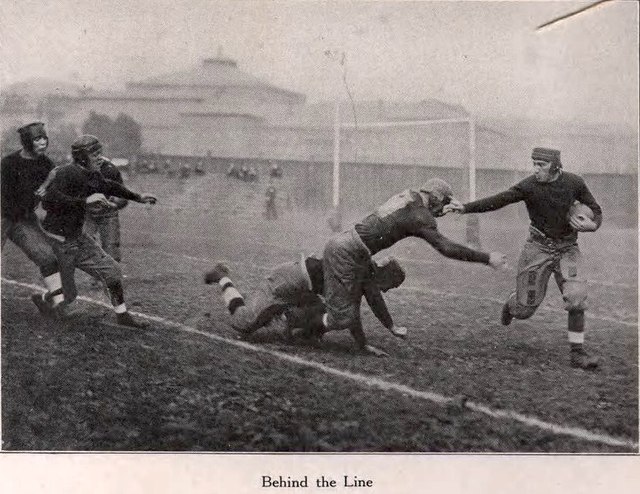Historian and author, Timothy Brown has written some great books on the history of football including Fields of Friendly Strife and How Football Became Football: 150 Years of the Game's Evolution. Tim also supplements his books with posts on his website FieldsofFriendlyStrife.com and one in particular caught my eye a little over a month ago. The subject was with the sometimes what we may consider crazy looking jersey numbers of the gridiron but what it really did was shed light on the genesis and evolution of the player numbering system we use today.
Jersey Number History
How did Jersey Numbers in Football Come About

Courtesy Wikimedia Commons, by and unknown photographer, action from a 1916 Pitt football game. Notice the tmporary canvas patch sewn on the backs of players, which had temporary numbers painted on them.
American football’s humble beginnings were derived directly from the games of rugby and association football, so it is no small wonder that the original upper torso gear of the stocking cap era gridders was also the apparel of choice for rugby players as well. The first jerseys of the gridiron were rugby-style tops with wool or cotton sweaters and no padding. Wool was chosen because the game was played outside in the frigid air of the Canadian provinces as well as the American North East. There was not a number on them to be found for the first 2 or three decades. The only adornments might be the school emblem or initial on the front.
Tim points out that, the Grand Ole Man of Football, Amos Alonzo Stagg may have been the first to think about placing number on the players for the fans to enjoy the game mor by recognizing players. The more common use of leather helmets disguiesed the identity of the men that toiled on the field. However Stagg halted putting digits on his University of Chicago players at the dawn of the 20th-Century when he worried that it would make the scouting of his players by opponents much easier. A Thanksgiving Day collegiate game in 1905 though between Iowa State and Drake did have unique numbers on the participants. The article says that the numbers were painted on pieces of canvas that had been sewn on the jersey back of each player in the game. 50 numbered shirts were provided with Drake using the first 25 and then Iowa State using the remaining number of 26 through 50. The idea came Brown says from a numbering system Harvard had used just a bit earlier in their new giant stadium to help fane identify players. The numbers were not on the players but a reference board at one end of the stadium numbered Harvard player names one through 25 and their opponent's players 26 through 50. If player number 4 on the board ran for a touchdown, they would post the number 4 so that pans could use the symbol to know whom had scored. It is assumbed that someone associated with the Drake and Iowa State game either witnessed the harvard practice of read/heard about it but adapted the system to placing the temporary numbers on the players themselves, with pained number of canvas patches sewn on the uniforms.

Courtesy Wikimedia Commons, by and unknown photographer, Michigan vs Case football game October 7, 1916. Location: Ferry Field Ann Arbor, MI. Present Day Case Western Reserve Spartans.
A litle over a decade from then there were conferences and then eventually national rules that wanted players to each have a number on during games. That was pretty much the extent of the rule just to have a number with no formal requirements per position like we see now. That is why legendary running back RedGrange wor number 77. Some coaches wanting to either buck the sytem or to just have fun with it did some really unique demonstrations of wearing numbers. Roman numberals, four digit numbers and even alpha-numeric combinations were expiramented with in early football. Tim Brown has some great examples in his whacky numbering article on his website with some awesome old photos that he dug up.
Eventually the numbers would correspond to offensive player positions but even that varied. At first they tried using the second number to be the position such as all ends numbers had to end in a one, tackles with a two and so on. The AAFC enven did one better by having center wear 20s, guards thirties and tackles forties while backs wore high numbers. The NCAA, NFHS and NFL eventually brought numbering closer to modern times when they dcided offensive interior numbers were to be 50-79, QBs to wear single and teens, halfbachs 20s and 30s and full backs 40s etc... Both the NFL and NCAA have opened this rule up even more to give players more choices and then game's numbers have gained enormous importance over the years.
The Photo Credits
The picture in the banner above is courtesy of Wikimedia Commons and was cropped from the 1968 - Neshaminy vs Dieruff High School Football Program - Allentown PA.


